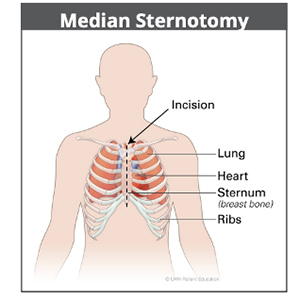The Toronto CTEPH Program receives referrals from physicians for patients who have a suspected diagnosis of CTEPH. Led by
Dr. Marc de Perrot and
Dr. Laura Donahoe, the program offers multidisciplinary assessment by surgeons, respirologists and radiologists who have expertise in the field of pulmonary hypertension and CTEPH.
Being the largest Canadian centre for pulmonary thromboendarterectomy (PEA) surgery, the program receives referrals from across the country. Our program is involved in:
- Evaluation of acute and chronic thromboembolic disease
- Education of patients and families about chronic thromboembolic pulmonary hypertension (CTEPH) and pulmonary thromboendarterectomy (PEA)
- Surgical management of CTEPH through PEA
- Interventional radiology management of CTEPH through Balloon Pulmonary Angioplasty (BPA)
- Increasing public and medical community awareness about CTEPH diagnosis and curative surgical treatment
- Clinical research
What is CTEPH?
Chronic thromboembolic pulmonary hypertension (CTEPH), similar to other types of pulmonary hypertension (PH), reduces blood flow and increases pressure in the blood vessels of the lung1. Breaking its name down helps us to understand what CTEPH is.
-
'Chronic' means a condition that lasts a long time (months-years)
-
'Thromboembolic' refers to the complete or partial blockage of a blood vessel by a blood clot that has broken away from where it was formed.
-
'Pulmonary' relates to the lungs.
-
'Hypertension' is the medical term for high blood pressure.
CTEPH is a type of pulmonary hypertension that is caused by unresolved or recurrent pulmonary emboli leading to chronic pulmonary vascular obstruction by an organized clot. The disease progresses despite adequate anticoagulation as a result of secondary arteriopathy eventually causing right heart failure and death.
Recognition of CTEPH in patients with a history of pulmonary emboli is important to achieve timely diagnosis and appropriate referral and follow-up.
Patients with CTEPH can present with acute pulmonary emboli. CTEPH should be suspected in the presence of:
- Idiopathic and/or recurrent pulmonary emboli
- Longer time between symptom onset and diagnosis
- Right ventricular systolic pressure > 50 mmHg on echocardiogram
- Large perfusion defects, mosaic parenchymal changes, and/or arterial webs or bands on CT Pulmonary Angiogram
Treatment for CTEPH
Pulmonary thromboendarterectomy (PEA) is the treatment of choice for CTEPH.
PEA surgery has 2 goals:
- To improve the blood flow in your lungs and treat your shortness of breath.
- To prevent the right side of your heart from weakening because of high blood pressure in your lung (pulmonary) vessels.
The PEA surgery leads to major clinical improvements due to improved hemodynamic parameters and oxygenation, and reduction in dead space ventilation. The surgery may also be curative in a large number of patients, with resolution of their pulmonary hypertension. The majority of patients experience significant functional recovery and can return to their baseline physical activity level without supplemental oxygen use.

Your surgeon makes an incision (cut) through your chest bone, called a Median Sternotomy. This allows them to reach your heart and major blood vessels.
Your heart and major blood vessels are connected to a heart-lung bypass machine. The bypass machine takes the blood away from your heart so your surgeon can clearly see the clot in your arteries. The machine also protects your body by cooling it to half its normal temperature. Once your body is cooled down, the heart-lung bypass machine can be stopped temporarily. This makes it safer to remove the scar tissue from your lung vessels.
Your surgeon makes incisions in your lung vessels so they can reach the scar tissue. The scar tissue is then removed from the inside of the artery walls on both sides of your lungs.
Once the scar tissue is removed, your chest bone is wired back together so it can heal. The wires won't need to be taken out and are safe for your body. They won't cause any problems with metal detectors in an airport.
After your surgery is done, we move you out of the operating room and will spend approximately two weeks in the hospital.
If PEA surgery is not a consideration, the CTEPH team will assess the patient to find other treatment options that may include:
- Pulmonary hypertension medication Riociguat®
- Balloon Pulmonary Angioplasty (BPA) – is a procedure that is done by an interventional radiologist at the Toronto General Hospital, to dilate pulmonary arteries that are obstructed by chronic scar tissue
How is the BPA procedure done?
A BPA is done by an interventional radiologist.
First, you will have an x-ray called a
pulmonary angiogram. The radiologist injects you with
contrast dye to show the blood flowing in your lungs. People with CTEPH have blood vessels in the lungs with webs of scar tissue. An angiogram helps the interventional radiologist find which blood vessels are blocked.
How does my CTEPH team decide if BPA is right for me?
BPA may be a treatment option for you
if:
- The clots or scar tissue that are blocking the blood vessels in your lungs are deep in the outer areas of your lungs and cannot be removed by PEA surgery.
- You have other medical conditions and you cannot have PEA surgery.
- You had PEA surgery and now have pulmonary hypertension. In this case, you will have a CT pulmonary angiogram. If this test shows leftover scar tissue in the lungs, and you are having shortness of breath, then the CTEPH team will talk with you about having a BPA procedure.
How to Prepare
- First appointments can take 90 minutes to 2 hours. During the first appointment, you will meet several health professionals who will do a detailed assessment of your health.
- You may also have some investigations on the same day as or before your clinic visit. You may be required to come to Toronto for CTEPH-specific testing such as a CT pulmonary angiogram.
- Follow-up appointments usually take 30 to 45 minutes.
- Visit the Pulmonary Hypertension Assocation of Canada website if you would like to connect with the PH/CTEPH community.
